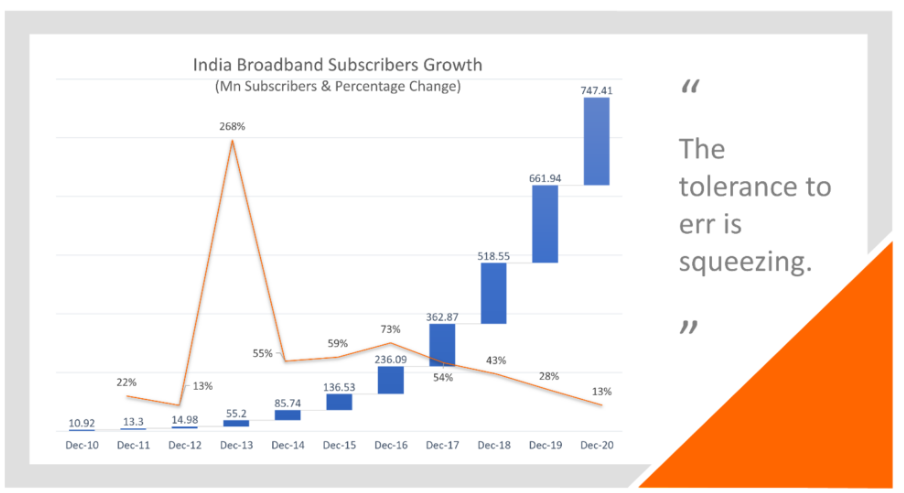Brands have to repeatedly reach out to the same set of users, and they need to live up to their reputation to knock on the same doors again and again.
The Indian broadband subscriber journey has been incredible over the past decade. By the end of 2020, India had over 747 million broadband subscribers over wireless and wired mediums as against a mere 10.92 million in December 2010. The threshold for defining broadband has also doubled from 256 KBPS to 512 KBPS. These broadband subscribers have become synonymous with Internet subscribers in India as narrowband technologies contribute insignificantly to the subscriber base.

For digital marketers, it’s great news that our Internet users are increasing and at the same time have broadband access where they can consume a lot of content as well as immersive ads. So, not only textual simple ads can be served, but brands can serve video and other rich multimedia ads also.
In 2016, when the widespread uptake of cellular broadband started in India after Jio commercially launched 4G LTE services, other operators like Airtel and Vodafone were pushed to quickly launch 4G services. We have seen many redefining moments in telecom since the entry of Jio.
But what is a matter of concern is we are adding up new subscribers at a declining growth rate. For instance, in 2017 we added 54% new broadband subscribers while fell to 13% in 2020. This is expected behavior as we are achieving complete coverage of the population in India through digital services.
For digital advertising, there is an important implication to understand.
Somewhere, we are okay to have inefficiencies in digital campaigns. Generally, we would make a mass outreach and expect certain industry norms-based engagement rates. Many marketers are fine with 2-3% CTR, which means for every 100 people reached, we expect a tangible outcome only from 2-3 people.
Now with this approach, we could afford the churn. Most likely, as 97-98% would not engage beyond a point, it would also hide the BOT engagement. Hence, ad fraud. Similarly, if anyone in the audience would not engage because of any brand safety issue, it would not make much of a difference earlier. The reason was, that there were still a lot of audiences available in subsequent campaigns with the overall digital user base growing in India.
But now, this place is saturated, and we don’t have much room left to add more new users. This means every time a campaign would be served to more or less the same audience. In this case, achieving the highest degree of Brand Safety with campaigns becomes very important. This will ensure that the audience being served with campaigns does not form a wrong perception about the brand which will discourage and disinterest them from engaging in the future.
Even though there is some degree of target marketing using digital mediums, a lot of it still happens through hit and trial and experimentation. This means a campaign manager has to reach out to the same profile many a time with different products and services to gauge the interest beyond as may be defined by key profile parameters. For instance, a specific audience profile might not be interested in a smartphone campaign but may be extremely interested in a TWS earbud campaign. While at the broader level, the campaign audience remains the same, the results of the campaign could differ remarkably.
For such instances, an advertiser cannot afford to lose a user basis any distasteful experience that primarily results from a brand safety issue. With the potential digital users hitting a plateau, there is little chance for any advertiser to widen the reach beyond a certain point. It has to nurture its audience without fail and keep them receptive to its campaigns always. The relevancy of the campaign may go high or low depending on other factors that are not defined by the profile. What is important is that the advertiser’s message is received positively and engaged further by a potential buyer to decide accordingly.
Advertisers and their agencies, have to realize the importance of brand safety, especially when a new addition to the digital user base is diminishing. They have to jointly ensure that the advertisement elements and the mediums through which they are delivered are brand-safe and do not result in an experience that pushes even a genuine user to discontinue the campaigns as its positioning is negatively impacted owing to brand safety issues like using an inappropriate keyword, insensitive messaging, false promise, or many such cases that panic a brand’s reputation.
The digital user base in India will not grow as before giving any advertiser fewer opportunities to get new users to engage every time. They will have to nurture the same set of people and cannot afford to go wrong by creating a bad impression. Earlier, inefficiencies or wrongs in a campaign were offset by targeting a fresh set of users. Now every advertiser and its partner have to be mindful of nurturing the community in a very clean and pure environment. That’s the new hygiene!




